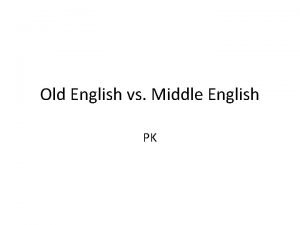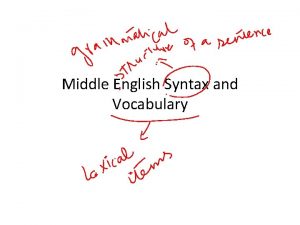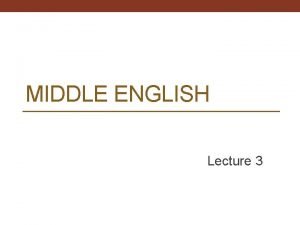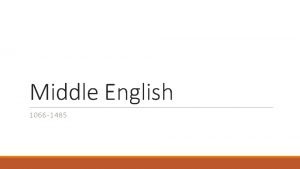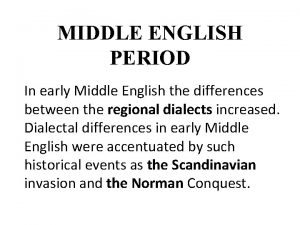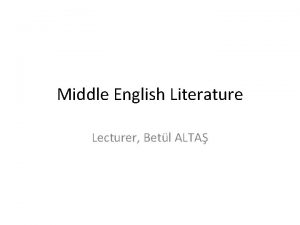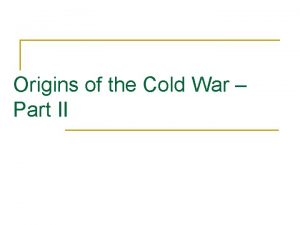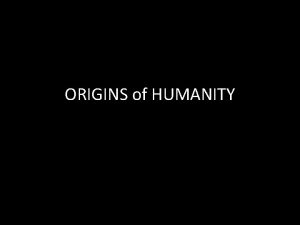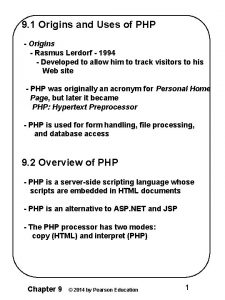THE ORIGINS OF MIDDLE ENGLISH How Middle English

















- Slides: 17

THE ORIGINS OF MIDDLE ENGLISH How Middle English came into existence

THE VERY BEGINNING Middle English, just as Modern English and Old English, is an INDO-EUROPEAN language That, however, doesn’t tell us a lot: � Indo-European languages include 443 languages and idiom spoken by roughly three billion humans, � Indo-European languages include languages as diverse as Bengali, English, French, German, Hindi, Persian, Portuguese, Russian, and Spanish

INDOEUROPEAN LANGUAGES (from 4000 BC up to 1000 BC)

CENTUM AND SATEM There are two major groups of INDOEUROPEAN LANGUAGES SATEM CENTU M INDOEUROPEA N

SATEM LANGUAGES

CENTUM LANGUAGES

CENTUM vs. SATEM

GERMANIC LANGUAGES Between 1500 BC and 1000 BC: the Nordic Bronze Age develops the pre-Proto-Germanic languages. Between 1000 BC– 500 BC: the formative phase of Proto Germanic. After 500 BC: we assume that the Proto Germanic language is now a separate language, which will later develop and diversify into the present-day Germanic languages

GERMANIC LANGUAGES The most important sound change which made Proto Germanic different from all other Indo. European languages was the so-called GRIMM’S LAW: � P>F , T>TH, K>X (later H): e. g. Latin pes, pedis > Mn. E fot; Latin tertius > Mn. E third; Latin canis > Mn. E hound � B>P, D>T, G>K: e. g. Latin verber > Mn. E warp; Latin decem> Mn. E ten; Latin gelu > Mn. E cold � Bh>B, Dh>D, Gh>G: e. g. Sanskrit bhrata > Mn. E brother; Sanskrit dwar > Mn. E door; Russian гусь > Mn. E goose


TIMELINE OF THE ENGLISH LANGUAGE

ENGLISH IN ITS INFANCY English is traditionally associated with the British Isles, however during the first four centuries of the first millennium AD there was no trace of English anywhere in the British Isles: � 55 BC – ROMANS ARRIVE � 410 AD – ROMANS DEPART � C. 449 AD – JUTES SETTLE IN KENT � 449 – ANGLES SETTLE IN NORTHUMBRIA AND MERCIA � 447 – SAXONS SETTLE IN SUSSEX, ESSEX, MIDDLESEX AND WESSEX EACH TRIBE SPOKE A DIALECT OF INGVAEONIC, A PROTO LANGUAGE WITHIN THE WESTGERMANIC BRANCH OF GERMANIC LANGUAGES.

ANGLO-SAXON INVASION

THE CELTS

TWO LITTLE GUYS THAT MADE ENGLISH POSSIBLE Two forms of the plague bacterium:

OLD ENGLISH Four distinct dialects formed: Kentish (Jutes); few extant texts Northumbrian (Angles), dominant in late 7 th century Mercian (Angles), dominant in early 8 th century (West) Saxon, dominant in 9 th& 10 th centuries; most extant texts are Saxon Northumbrian (8 th C) West Saxon (11 th C) : Nu we sceolan herigean : Nu scylun hergan hefaenricaes uard, Metudæs maecti end his modgidanc, Uerc uuldurfadur, sue he uundra gihuaes, Eci dryctin, or astelidæ. heofonrices weard, Metodes mihte 7 his modgeþanc, Wera wuldorfæder, swa he wuldres gehwæs, Ece drihten, ord onstealde. Translation: Now we shall praise the keeper of the heavenly kingdom, the power of the lord of destiny and his imagination, the deeds of the glorious father, when of every glorious thing he, the eternal lord, ordained the beginning

 Examples of old english
Examples of old english Hát kết hợp bộ gõ cơ thể
Hát kết hợp bộ gõ cơ thể Frameset trong html5
Frameset trong html5 Bổ thể
Bổ thể Tỉ lệ cơ thể trẻ em
Tỉ lệ cơ thể trẻ em Gấu đi như thế nào
Gấu đi như thế nào Tư thế worm breton
Tư thế worm breton Bài hát chúa yêu trần thế alleluia
Bài hát chúa yêu trần thế alleluia Môn thể thao bắt đầu bằng từ đua
Môn thể thao bắt đầu bằng từ đua Thế nào là hệ số cao nhất
Thế nào là hệ số cao nhất Các châu lục và đại dương trên thế giới
Các châu lục và đại dương trên thế giới Công thức tiính động năng
Công thức tiính động năng Trời xanh đây là của chúng ta thể thơ
Trời xanh đây là của chúng ta thể thơ Mật thư tọa độ 5x5
Mật thư tọa độ 5x5 Làm thế nào để 102-1=99
Làm thế nào để 102-1=99 Phản ứng thế ankan
Phản ứng thế ankan Các châu lục và đại dương trên thế giới
Các châu lục và đại dương trên thế giới Thể thơ truyền thống
Thể thơ truyền thống
